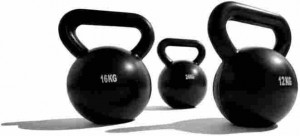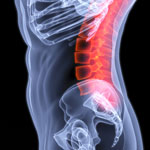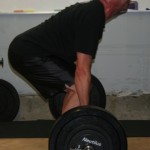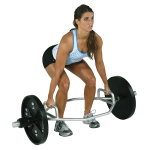Brian Schiff’s Blog
Injury Prevention, Sports Rehab & Performance Training Expert
Long lever abdominal exercises are popular. However, they also pose a risk for the lumbar spine given the relatively poor abdominal strength/control and lever arm created by momentum and the iliopsoas muscle. The stress on the lumbar spine is high as the leg (s) come back down due to reverse muscle action via the attachment of the iliopsoas on the lower lumbar spine. As a result, this can cause a sizable shear force on the spine.
I counsel patients and athletes with prior history of disc pathology to be very careful with any long lever or ballistic abdominal exercises with straight legs as the physics may present higher risk than reward and create excess strain on the spine. While a single workout may not cause harm, there can be a gradual repetitive overload that creates weakness or harm to the disc and/or spine. This exercise from my Functionally Fit column promotes strength and core or pillar stability through resisting excessive spinal extension.

Kettlebells are very popular training tools these days. I find them useful in many ways – improving grip strength, core activation, asymmetrical loading, etc. With that said, I also feel with movement flaws and/or improper technique, they carry an inherent injury risk.
It is interesting to note that some people find swings to be very therapeutic and good for their back, while others who are capable of lifting very high loads with traditional lifts find them to be irritating to the spine. So why is this?
If you are like me, knowing the “why” or “cause and effect” behind exercise is very important. I am not one to blindly use an exercise without knowing its intended purpose and then quantifying risk vs. reward and results. So, it was with great interest I read Stuart McGill and Leigh Marshall’s recent article on kettlebell swings, snatches and bottoms-up carries in the NSCA Journal of Strength & Conditioning Research (Jan 2012).
While the sample size is small, I think the article provides some gems in regard to training given no one has really looked at spine loading during various swings and carries. The authors used surface EMG to record muscle activation of the back, hip and core muscles throughout the various exercises – swing, swing with Kime (abdominal pulse at top of the swing), swing to snatch, racked carry and bottoms-up carry.
Without going into all the tiny details, I wanted to share what I consider to be some key takeaways for rehab and training:
- Unlike traditional low back extension exercises such as lifting a bar or squatting exercises, the swing creates a relatively high posterior shear force (namely L4 on L5) in relation to the compressive load – this may explain why some powerlifters have no issues with heavy dead lifts but are bothered by swings
- Both compressive and shear forces were highest at the beginning of the swing
- From a compressive standpoint loads with a 16 kg kettlebell (swing) are less than one-half of that of lifting 27 kg on an Olympic bar and these would seemingly pose a low relative injury risk
- KB swings do appear to require sufficient spine stability in this shear mode to ensure that is is a “safe” exercise selection
- Those with back pain develop movement flaws and the authors report one of the most common is to move the spine under load instead of the hips – so instead of hip hinging, injured clientele are more apt to shift or bend the spine leading to repetitive and harmful forces
- A modified approach to swings with careful cueing and progression is suggested for clinicians
- The bottoms-up carry poses more challenge to the core musculature likely due to requiring more grip strength (thus stiffening the core per McGill in Ultimate Back Fitness & Performance) as well as necessitating more control to carry it, hence making it a good choice for training in terms of activation of these muscles
So, in my mind kettlebell training (like any other form of training) requires proper form, movement assessment and an intimate knowledge of the client’s medical and training history. In addition to that, we must carefully scrutinize execution of the exercise and deliver appropriate feedback and analysis.
While maximal shear occurs at the bottom, I cannot help but wonder about the potential impact of tight iliopsoas muscles given their unique relationship to the lumbar spine and reverse muscle action. It would be interesting to know if those with a greater anterior tilt and tightness are more likely to experience higher shear forces or potential back soreness over time.
This brings the discussion back to quality of movement and movement assessment. In my mind, adequately assessing the hips (flexibility, strength and stability) is also a key variable in determining how best to approach integrating the swings. As Gray would say, the lumbar spine needs stability while the hips require mobility.
A lack of hip mobility is definitely a relative precaution for swings in my mind. On top of that, fundamental hip strength/stability and core strength should be evident. Perhaps even regressing to rudimentary hip thrusts and bridges may be the best place to start for those needing a primer on form and proper movement before moving to a basic swing.
Nonetheless, a big thanks to Stuart McGill and Leigh Marshall for this work and giving us some practical food for thought. I hope this information helps you as much as it did me. May your training be safe and effective!
I think it is safe to say most would agree that deadlifts are great for building maximal lower body strength. Elite Olympic weightlifters are generally able to lift more loads in this lift compared to other free weight exercises. I know personally that I like to use it to develop lumbar extensor strength, as well as in place of the squat if I want to avoid spinal compression from the weight of the bar.
In the past I have heard some strength coaches say they don’t use a hex bar for deadlifts because it is not the same as lifting a straight bar. While not always sure exactly what they mean by that, I found a recent article in the July 2011 Journal of Strength & Conditioning Research very insightful. The researchers looked at the difference between straight and hexagonal bar deadlifts in submax loading situations.
The concern with deadlifting has always been stress on the spine. The study notes:
“For world class athletes lifting extremely heavy loads, lumbar disk compression forces as large as 36,400 N have been reported.”
Lifters have long been encouraged to keep the barbell as close to them as possible to reduce the moment arm. The issue with the straight bar is that it can impinge on the body. Thus, the trap bar or hex bar apparatus was developed. The researchers hypothesized that the hex bar would reduce the joint movements and resistance moment arms. In addition, they hypothesized that larger forces would be produced with the submax loads.
The study use 19 male powerlifters and was conducted 3 months after their most recent competition where most were at the end of a training cycle aimed at matching or exceeding their previous competition performance. The subjects (following their own warm-up) performed HBD and SBD at 10, 20, 30, 40, 50, 60, 70 and 80% of his SBD 1RM. Twelve markers were placed on the body for biomechanical analysis.




